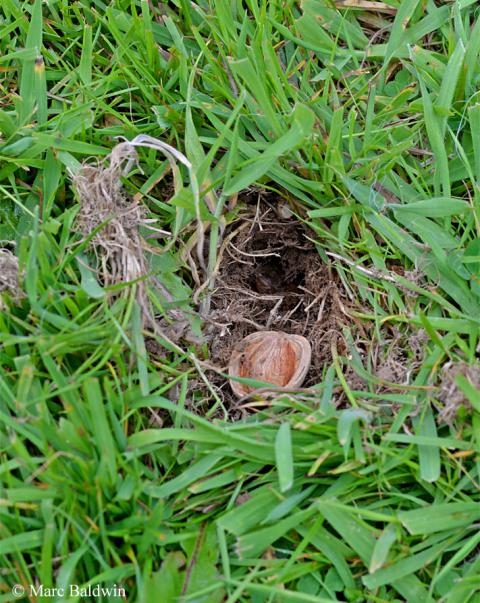Squirrel Food & Feeding - Larders
Surplus food is cached (i.e. buried) for retrieval when food is scarce; nuts (e.g. beech mast, hazel) and seeds (e.g. acorns) are generally cached during late summer and autumn for retrieval in winter. Typically, Grey and Red squirrels scatter cache, which means they hide each food item separately (occasionally two or three small items), rather than putting them together in a single large "larder". Caches tend to be made in tree cavities or in shallow pits that they dig into the ground using their forepaws; those made in the ground are just large enough to contain the item being stored and are well covered over. Caches I excavated one afternoon in 2015 were about 2.5cm wide and 3cm deep (ca. 1 x 1 inch), each containing a single hazel nut. Red squirrels will also cut fungal fruiting bodies and cache them singly in trees to dry out. The cache recovery rate is variable and appears to be related to the mast crop (i.e. the abundance of food).

In a 1989 article to Natural History, Lucia Jacobs, at the University of California Berkeley, reports a nut recovery rate as high as 95% for Grey squirrels in North America. Conversely, in an article to the same journal in 1994, Michael Steele and Peter Smallwood note that in years where the mast crop is high, as few as 26% of cached nuts may be recovered. In the USA (and presumably also in the UK), where squirrels feed on rapidly germinating oaks, they have been observed to bite out the seed-germ tip before burying the acorn – this kills the radical and prevents the acorn germinating, prolonging the life of the cache.

While data are lacking for Red squirrels, Grey squirrels seem to have a good spatial memory and exhibit learned cache retrieval – that is to say, the squirrels use episodic memory to relocate caches. Between January 1993 and September 1994, Exeter University biologist Isabel MacDonald studied the cache retrieval of Red and Grey squirrels and found her Grey subjects could remember the location of 24 cached nuts for up to 62 days, while the Reds seemed to have forgotten the locations of their caches after 34 days. MacDonald's data were collected with only a handful of subjects, so we must be very cautious about drawing too many conclusions, but the implication is that Greys have better memories for caches than Reds. Lucia Jacobs and Emily Liman, in their 1991 paper to Animal Behaviour, suggest that Greys may also be able to remember the type of seed in the cache, as well as its location, although to the best of my knowledge this has yet to be studied.
In addition to possibly having better memories for their own caches, there are some data suggesting they’re also good at locating and retrieving caches made by Reds, particularly during the winter. In a 2002 paper to the journal Behavioural Ecology and Sociobiology, veteran squirrel biologists Luc Wauters, Guido Toso and John Gurnell concluded that "... cache pilfering [by Greys] is likely to reduce reproductive output in red squirrels, and thus play a role in the replacement of red by grey squirrels." The biologists also timed how long Reds took to cache and eat various types of nuts they were presented with. Hazelnuts took 1 minute 24 seconds to cache, chestnuts 1:30, walnuts 2:18 and black walnuts 2:24.
The question of how exactly squirrels remember the locations of their caches is still a matter of debate, but it is thought they may use landmarks (e.g. trees, stumps, bushes, etc.) as references and MacDonald found that none of the decoys she buried more than 20 cm (8 in.) from the original cache site were recovered, suggesting that the squirrels were remembering a fairly specific area. There is no evidence, that I know of, to suggest that they remember the exact spot (i.e. the exact inch-squared plot in which the nut is buried), but they do seem to remember the general area of the cache and olfaction is probably used to home in on it. Indeed, I have observed Greys come down from a tree and straight across grass and come to a stop before starting to sniff around. In such cases it seems that vision (and presumably spatial memory) gets them to the rough spot and their noses lead them to the prize.

Squirrels are also highly aware of their surroundings while caching their prize and will make fake caches (i.e. pretending to bury the nut or seed in one spot but surreptitiously carrying it elsewhere) if they think they're being watched by either a human or another squirrel; this behaviour is known among Red and Grey squirrels. See the associated QA for more detailed coverage of caching behaviour in squirrels.